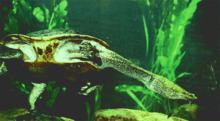Class Sauropsida Scientific name Chelodina burrungandjii | Phylum Chordata Order Testudines Rank Species | |
 | ||
Similar Chelodina canni, Chelodina steindachneri, Red‑faced turtle, Emydura tanybaraga, Gulf snapping turtle | ||
The Sandstone Snake-necked Turtle (Chelodina (Macrochelodina) burrungandjii) is a medium-sized turtle reaching carapace lengths of 316 mm. The species is found in the sandstone plateaus and escarpments and the plunge pools of Arnhem Land of the Northern Territory. The species had been long recognised as valid. However, it had been difficult to research due to the remoteness of its habitat. The species occurs in proximity to Chelodina oblonga, to which it is closely related. For the most part the two species are parapatric in distribution. However, they do come together in limited locations such as plunge pools at the base of the escarpments. In these areas there is hybridization between the species.
Taxonomy
When initially described, populations in the Kimberley Region were also assigned to this species. But later the species Chelodina walloyarrina McCord and Joseph-Ouni 2007:59 was described and initially was synonymised with Chelodina burrungandjii, but it is now considered a valid species. The closest relatives of the Sandstone Longneck Turtle are Chelodina walloyarrina and Chelodina oblonga, and along with Chelodina expansa, Chelodina kuchlingi and Chelodina parkeri they make up the subgenus Macrochelodina which are strike and gape piscivores with reduced plastra, enlarged back feet and legs and flattened heads with large mouths. They are differentiated from the subgenus Chelodina, which have more complete plastrons, smaller necks and are not strike and gape predators. The last group in the Chelodina is Macrodiremys containing a single species Chelodina colliei from south-west Australia. This species is similar to the South American Hydromedusa in many respects.
